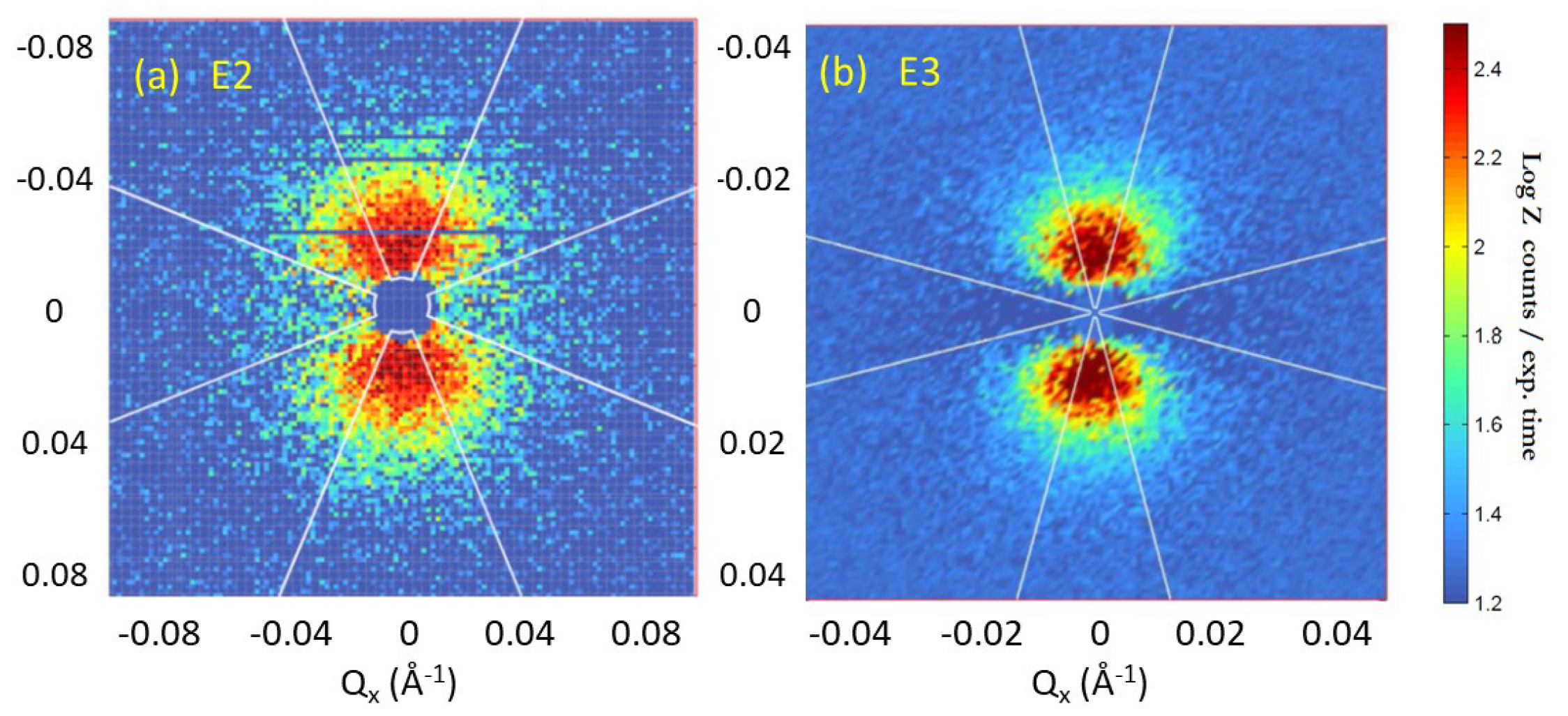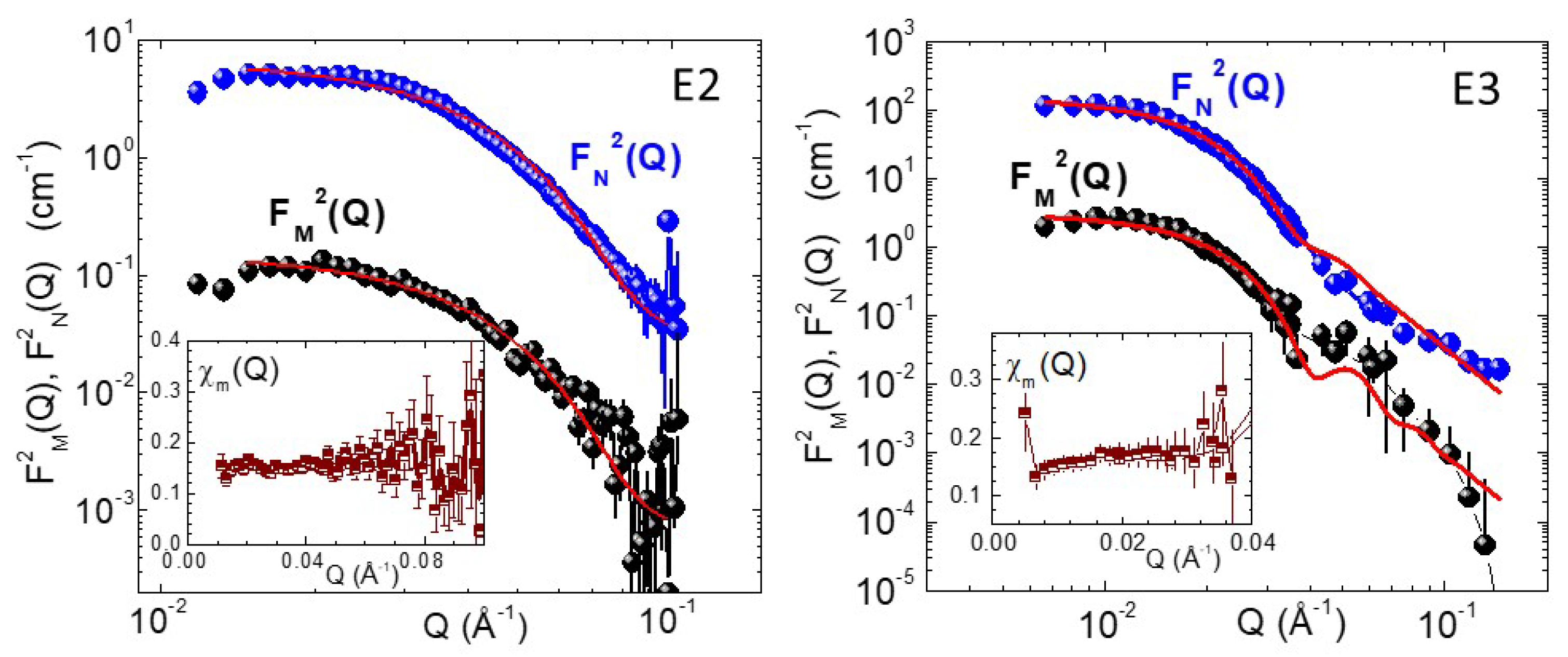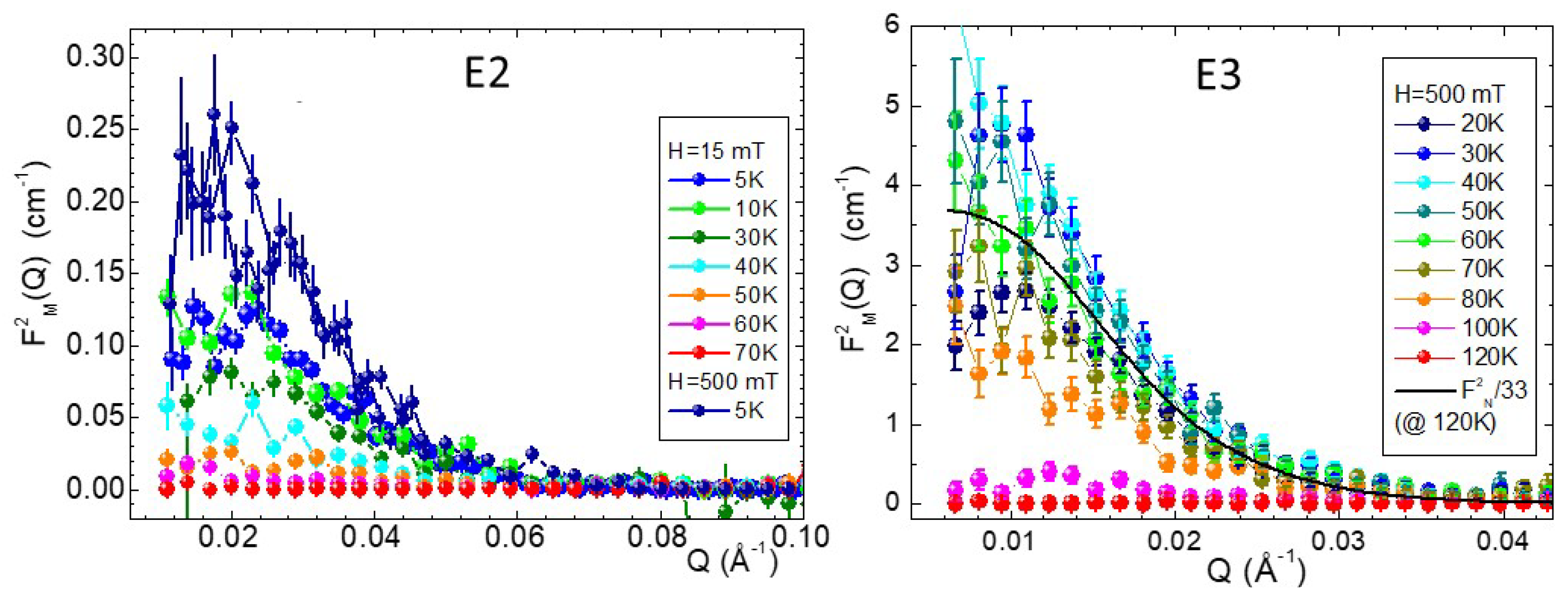Accessing the Magnetic Morphology of Ferromagnetic Molecular-Based Nanoparticles from Polarized Small-Angle Neutron Scattering
Abstract
1. Introduction
2. Results and Discussion
3. Materials and Methods
3.1. Samples
3.2. SANS Experimental Details
4. Conclusions
Funding
Institutional Review Board Statement
Informed Consent Statement
Data Availability Statement
Acknowledgments
Conflicts of Interest
Abbreviations
| SANS | Small-Angle Neutron Scattering |
| SLD | (neutron) Scattering Length Density |
| MNP | Magnetic Nano-Particles |
| CTA | Cetyltrimethylammonium |
| PVP | Polyvinylpyrrolidone |
Appendix A. SANS from Magnetic Nanoparticles
Appendix A.1. Nuclear Scattering
Appendix A.2. Magnetic Scattering
Appendix A.3. Scattering of Magnetized Particles
- For (high temperature and/or low field), and thusThere is an equiprobable distribution of magnetization directions and the factor originates from the orientational average of the magnetization vector.
- For (low temperature and/or high field), and thusThis is the expression for fully magnetized particles.
Appendix A.4. Geometrical Form Factors
References
- Krahne, R.; Morello, G.; Figuerola, A.; George, C.; Deka, S.; Manna, L. Physical properties of elongated inorganic nanoparticles. Phys. Rep. 2011, 501, 75–221. [Google Scholar] [CrossRef]
- Prado, Y.; Lisnard, L.; Heurtaux, D.; Rogez, G.; Gloter, A.; Stéphan, O.; Dia, N.; Rivière, E.; Catala, L.; Mallah, T. Tailored coordination nanoparticles: Assessing the magnetic single-domain critical size. Chem. Commun. 2011, 47, 1051. [Google Scholar] [CrossRef] [PubMed]
- Bohra, M.; Alman, V.; Showry, A.; Singh, V.; Diaz, R.E.; Sowwan, M.; Grammatikopoulos, P. Aggregation vs Surface Segregation: Antagonism over the Magnetic Behavior of NiCr Nanoparticles. ACS Omega 2020, 5, 32883. [Google Scholar] [CrossRef]
- Bohra, M.; Battula, S.V.; Alman, V.; Annadi, A.; Singh, V. Design of various NiCr nanostructures and deducing their magnetic anisotropy. Appl. Nanosci. 2023, 13, 3205. [Google Scholar] [CrossRef]
- Bedanta, S.; Kleemann, W. Supermagnetism. J. Phys. D Appl. Phys. 2009, 42, 013001. [Google Scholar] [CrossRef]
- Catala, L.; Volatron, F.; Brinzei, D.; Mallah, T. Functional Coordination Nanoparticles. Inorg. Chem. 2009, 48, 3360. [Google Scholar] [CrossRef]
- Nakotte, H.; Shrestha, M.; Adak, S.; Boergert, M.; Zapf, V.S.; Harrison, N.; King, G.; Daemen, L.L. Magnetic properties of some transition-metal Prussian Blue Analogs with composition M[M(C,N)].xHO. J. Sci. Adv. Mater. Devices 2016, 1, 113. [Google Scholar] [CrossRef]
- Catala, L.; Gacoin, T.; Boilot, J.-P.; Rivière, E.; Paulsen, C.; Lhotel, E.; Mallah, T. Cyanide-Bridged CrIII–NiII Superparamagnetic Nanoparticles. Adv. Mater. 2003, 15, 826. [Google Scholar] [CrossRef]
- Prado, Y.; Mazérat, S.; Rivière, E.; Rogez, G.; Gloter, A.; Stéphan, O.; Catala, L.; Mallah, T. Magnetization Reversal in CsNiIICrIII(CN)6 Coordination Nanoparticles: Unravelling Surface Anisotropy and Dipolar Interaction Effects. Adv. Funct. Mater. 2014, 24, 5402. [Google Scholar] [CrossRef]
- Gadet, V.; Mallah, T.; Castro, I.; Verdaguer, M.; Veillet, P. High-TC molecular-based magnets: A ferromagnetic bimetallic chromium(III)-nickel(II) cyanide with TC = 90 K. J. Am. Chem. Soc. 1992, 114, 9213–9214. [Google Scholar] [CrossRef]
- Ridier, K.; Gillon, B.; André, G.; Chaboussant, G.; Catala, L.; Mazérat, S.; Mallah, T. Small-angle neutron scattering study of the short-range organization of dispersed CsNi[Cr(CN)6]. J. Appl. Phys. 2015, 118, 114304. [Google Scholar] [CrossRef]
- Ridier, K.; Gillon, B.; Chaboussant, G.; Catala, L.; Mazérat, S.; Rivière, E.; Mallah, T. Individual-collective crossover driven by particle size in dense assemblies of superparamagnetic nanoparticles. Eur. Phys. J. B 2017, 90, 77. [Google Scholar] [CrossRef]
- Lee, S.H.; Lee, D.H.; Jung, H.; Han, Y.-S.; Kim, T.-H.; Yang, W. Magnetic properties of SiO2-coated iron oxide nanoparticles studied by polarized small angle neutron scattering. Curr. Appl. Phys. 2015, 15, 915. [Google Scholar] [CrossRef]
- Kons, C.; Phan, M.-H.; Srikanth, H.; Arena, D.A.; Nemati, Z.; Borchers, J.A.; Krycka, K.L. Investigating spin coupling across a three-dimensional interface in core/shell magnetic nanoparticles. Phys. Rev. Mater. 2020, 4, 034408. [Google Scholar] [CrossRef]
- Honecker, D.; Ferńandez-Barquín, L.; Bender, P. Magnetic structure factor of correlated moments in small-angle neutron scattering. Phys. Rev. B 2020, 101, 134401. [Google Scholar] [CrossRef]
- Oberdick, S.D.; Borchers, J.A.; Krycka, K.L. Magnetic correlations of iron oxide nanoparticles as probed by polarized SANS in stretched magnetic nanoparticle elastomer composites. Appl. Phys. Lett. 2022, 120, 052401. [Google Scholar] [CrossRef]
- Honecker, D.; Bersweiler, M.; Erokhin, S.; Berkov, D.; Chesnel, K.; Venero, D.A.; Qdemat, A.; Disch, S.; Jochum, J.K.; Michels, A.; et al. Using small-angle scattering to guide functional magnetic nanoparticle design. Nanoscale Adv. 2022, 4, 1026. [Google Scholar] [CrossRef]
- Das, B.; Batley, J.T.; Krycka, K.L.; Borchers, J.A.; Quarterman, P.; Korostynski, C.; Nguyen, M.; Kamboj, I.; Aydil, E.S.; Leighton, C. Chemically Induced Magnetic Dead Shells in Superparamagnetic Ni Nanoparticles Deduced from Polarized Small-Angle Neutron Scattering. ACS Appl. Mater. Interfaces 2022, 14, 33491. [Google Scholar] [CrossRef]
- Kons, C.; Krycka, K.L.; Robles, J.; Ntallis, N.; Pereiro, M.; Phan, M.-H.; Srikanth, H.; Borchers, J.A.; Arena, D. Influence of Hard/Soft Layer Ordering on Magnetization Reversal of Bimagnetic Nanoparticles: Implications for Biomedical/Theranostic Applications. ACS Appl. Nano Mater. 2023, 6, 10986. [Google Scholar] [CrossRef]
- Mülhbauer, S.; Honecker, D.; Périgo, É.A.; Bergner, F.; Disch, S.; Heinemann, A.; Erokhin, S.; Berkov, D.; Leighton, C.; Eskildsen, M.R.; et al. Magnetic small-angle neutron scattering. Rev. Mod. Phys. 2019, 91, 015004. [Google Scholar] [CrossRef]
- Belloni, L. La Diffusion de Neutrons aux Petits Angles: Mécanique statistique des liquides et traitement des données. Collection SFN 2010, 11, 71. [Google Scholar] [CrossRef]
- Bersweiler, M.; Oba, Y.; Pratami Sinaga, E.; Peral, I.; Titov, I.; Adams, M.P.; Rai, V.; Metlov, K.L.; Michels, A. Fingerprint of vortexlike flux closure in an isotropic Nd-Fe-B bulk magnet. Phys. Rev. 2023, 108, 094434. [Google Scholar] [CrossRef]
- Adams, M.P.; Michels, A.; Kachkachib, H. Magnetic neutron scattering from spherical nanoparticles with Néel surface anisotropy: Atomistic simulations. J. Appl. Cryst. 2022, 55, 1488. [Google Scholar] [CrossRef]
- Chaboussant, G.; Désert, S.; Brûlet, A. Recent developments and projects in SANS instrumentation at LLB-Orphée. Eur. Phys. J. Spec. Top. 2012, 213, 313. [Google Scholar] [CrossRef]
- Chaboussant, G.; Désert, S.; Lavie, P.; Brûlet, A. PA20: A new SANS and GISANS project for soft matter, materials and magnetism. J. Phys. Conf. Ser. 2012, 340, 012002. [Google Scholar] [CrossRef]
- Dewhurst, C.D. Graphical reduction and analysis small-angle neutron scattering program: GRASP. J. Appl. Crystallogr. 2023, 56, 1595. [Google Scholar] [CrossRef]
- Kodama, R.H.; Berkowitz, A.E.; McNiff, E.; Foner, S. Surface spin disorder in NiFe2O4 nanoparticles. Phys. Rev. Lett. 1996, 77, 394. [Google Scholar] [CrossRef]
- Mirebeau, I.; Hennion, M. Diffusion de neutrons aux petits angles (DNPA) et magnétisme: Concepts et applications. J. Phys. IV 1999, 9, 51. [Google Scholar] [CrossRef][Green Version]
- Wiedenmann, A.; Kammel, M.; Heinemann, A.; Keiderling, U. Nanostructures and ordering phenomena in ferrofluids investigated using polarized small angle neutron scattering. J. Phys. Cond. Mat. 2006, 18, 2713. [Google Scholar] [CrossRef]
- Wiedenmann, A. Polarized SANS for probing magnetic nanostructures. Physica B 2005, 356, 246. [Google Scholar] [CrossRef]
- Disch, S.; Wetterskog, E.; Hermann, R.P.; Wiedenmann, A.; Vainio, U.; Salazar-Alvarez, G.; Bergström, L.; Brückel, T. Quantitative spatial magnetization distribution in iron oxide nanocubes and nanospheres by polarized small-angle neutron scattering. New J. Phys. 2012, 14. [Google Scholar] [CrossRef]





Disclaimer/Publisher’s Note: The statements, opinions and data contained in all publications are solely those of the individual author(s) and contributor(s) and not of MDPI and/or the editor(s). MDPI and/or the editor(s) disclaim responsibility for any injury to people or property resulting from any ideas, methods, instructions or products referred to in the content. |
© 2025 by the author. Licensee MDPI, Basel, Switzerland. This article is an open access article distributed under the terms and conditions of the Creative Commons Attribution (CC BY) license (https://creativecommons.org/licenses/by/4.0/).
Share and Cite
Chaboussant, G. Accessing the Magnetic Morphology of Ferromagnetic Molecular-Based Nanoparticles from Polarized Small-Angle Neutron Scattering. Inorganics 2025, 13, 202. https://doi.org/10.3390/inorganics13060202
Chaboussant G. Accessing the Magnetic Morphology of Ferromagnetic Molecular-Based Nanoparticles from Polarized Small-Angle Neutron Scattering. Inorganics. 2025; 13(6):202. https://doi.org/10.3390/inorganics13060202
Chicago/Turabian StyleChaboussant, Grégory. 2025. "Accessing the Magnetic Morphology of Ferromagnetic Molecular-Based Nanoparticles from Polarized Small-Angle Neutron Scattering" Inorganics 13, no. 6: 202. https://doi.org/10.3390/inorganics13060202
APA StyleChaboussant, G. (2025). Accessing the Magnetic Morphology of Ferromagnetic Molecular-Based Nanoparticles from Polarized Small-Angle Neutron Scattering. Inorganics, 13(6), 202. https://doi.org/10.3390/inorganics13060202






